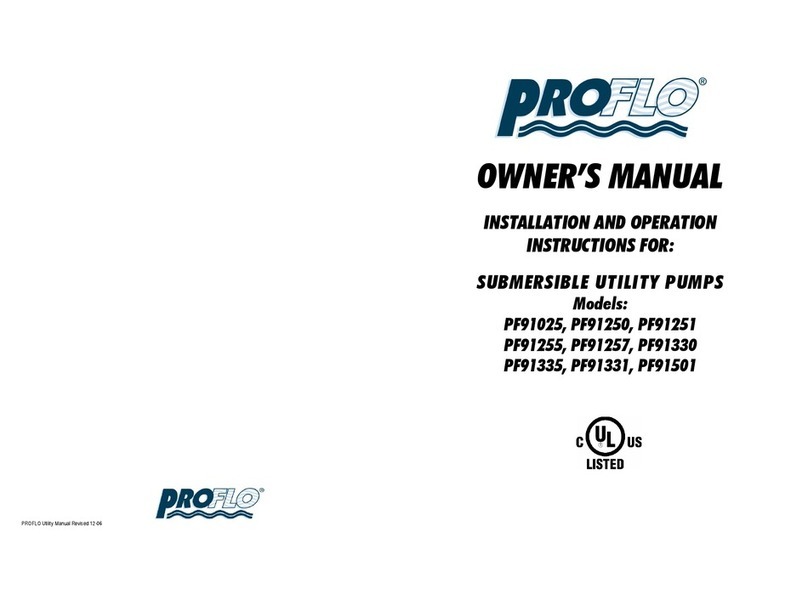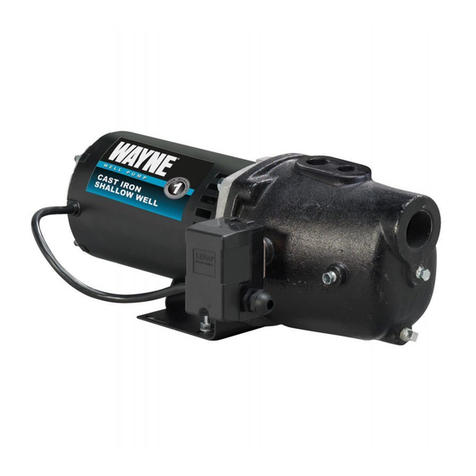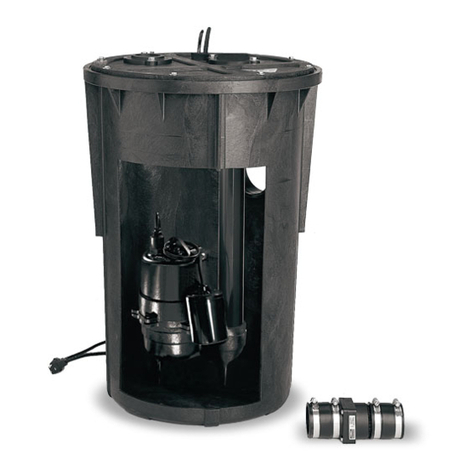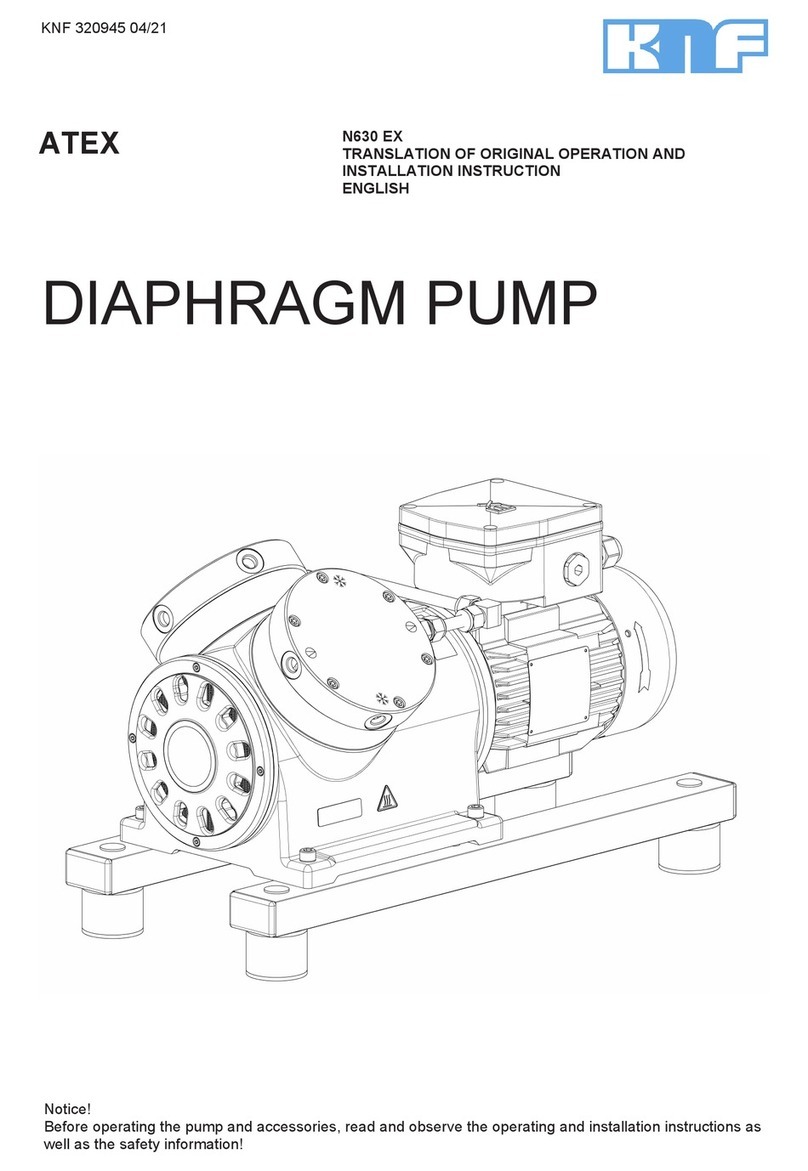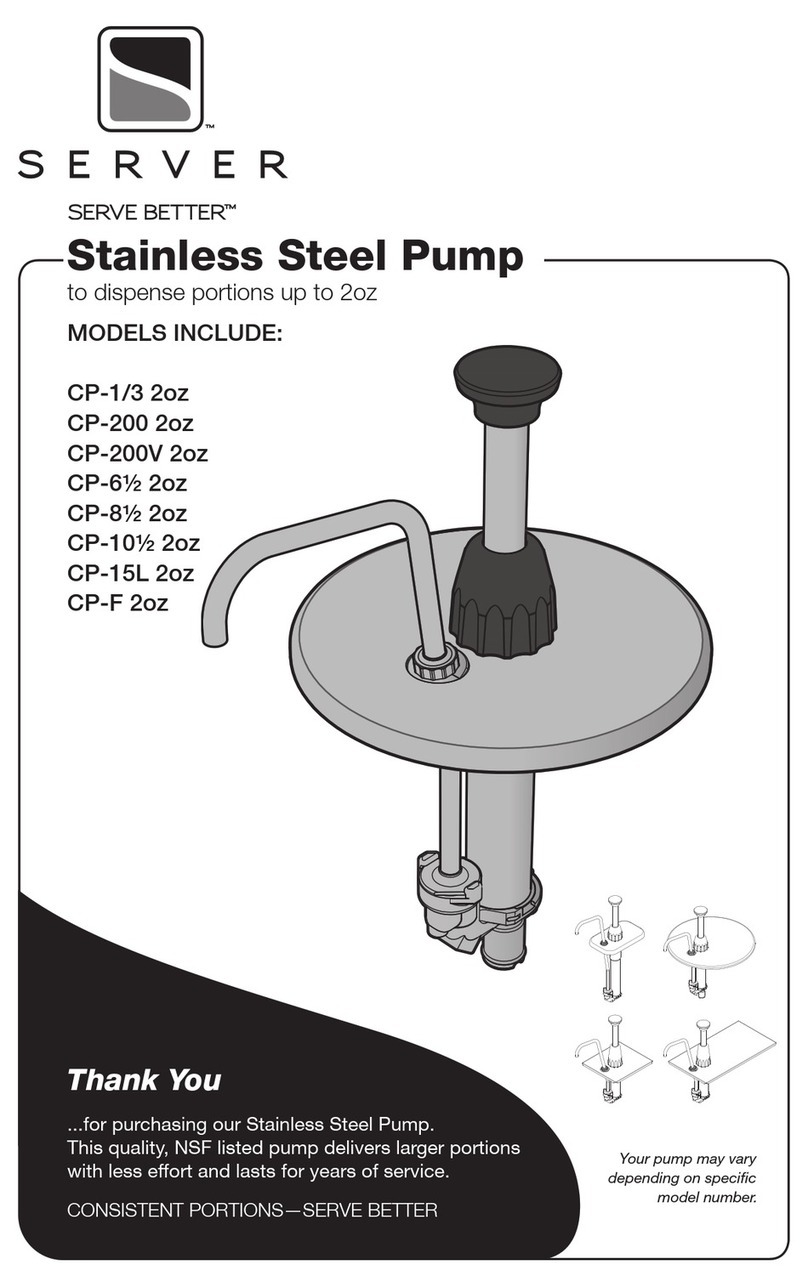Ingersoll-Dresser A Series Owner's manual

A PUMP
INSTALLATION
OPERATION &
MAINTENANCE
Ingersoll-Rand Pacific Worthington Pleuger Scienco Jeumont-Schneider Pumps
Ingersoll-Dresser Pumps
™


A PUMP INSTALLATION, OPERATION, AND MAINTENANCE
iii DO2664-07
TABLE OF CONTENTS
1. INTRODUCTION .........................................................................................................................1-1
1.1 SAFETY....................................................................................................................................1-1
1.2 SAFETY NOTICES ..................................................................................................................1-1
1.3 CONSTRUCTION ....................................................................................................................1-2
1.3.1 CASING .............................................................................................................................1-2
1.3.2 IMPELLER ........................................................................................................................1-2
1.3.3 STUFFING BOXES...........................................................................................................1-2
1.3.4 SHAFT ...............................................................................................................................1-2
1.3.5 BEARING HOUSING .......................................................................................................1-2
1.3.6 BEARINGS........................................................................................................................1-2
1.3.7 COUPLING/COUPLING GUARD ...................................................................................1-3
1.3.8 MECHANICAL SEAL ......................................................................................................1-3
1.3.9 STABILIZER .....................................................................................................................1-3
1.3.10 BASEPLATE ...................................................................................................................1-3
2. RECEIVING AND STORAGE....................................................................................................2-1
2.1 RECEIPT INSPECTION...........................................................................................................2-1
2.2 LIFTING....................................................................................................................................2-1
2.2.1 LIFTING COMPLETE UNIT............................................................................................2-1
2.2.2 LIFTING DRIVER.............................................................................................................2-2
2.2.3 LIFTING PUMP ................................................................................................................2-2
2.3 STORAGE.................................................................................................................................2-3
2.3.1 PREPARATION FOR STORAGE ....................................................................................2-3
2.3.2 STORAGE AREA..............................................................................................................2-4
2.3.3 INSPECTION AND MAINTENANCE.............................................................................2-4
2.3.3.1 Six Months Prior to Installation ..................................................................................2-4
2.3.3.2 One Month Prior to Installation...................................................................................2-5
2.3.4 PAINTING AND PRESERVATION.................................................................................2-5
2.3.5 ASSOCIATED EQUIPMENT ...........................................................................................2-5
2.4 PREPARATION FOR INSTALLATION & OPERATION .....................................................2-5
3. INSTALLATION ..........................................................................................................................3-1
3.1 FOUNDATION AND PIPING .................................................................................................3-1
3.1.1 LOCATION .......................................................................................................................3-1
3.1.2 PIPING ...............................................................................................................................3-1
3.1.2.1 Suction Strainer ...........................................................................................................3-1
3.1.2.2 Bypass Line .................................................................................................................3-2
3.1.3 FOUNDATION..................................................................................................................3-2
3.1.4 LEVELING THE BASEPLATE........................................................................................3-3
3.1.5 GROUTING .......................................................................................................................3-5
3.2 SHAFT ALIGNMENT..............................................................................................................3-5
3.2.1 ALIGNMENT FREQUENCY ...........................................................................................3-6
3.2.2 ALIGNMENT PRECONDITIONS....................................................................................3-6
3.2.3 SETTING MOTOR SHAFT END SPACE........................................................................3-6
3.2.4 TAPPING DRIVER MOUNT PADS ................................................................................3-8
3.2.5 COLD ALIGNMENT ........................................................................................................3-9

A PUMP INSTALLATION, OPERATION, AND MAINTENANCE
DO2664-07 iv
TABLE OF CONTENTS
(CONTINUED)
3.2.6 HOT ALIGNMENT......................................................................................................... 3-13
4. OPERATION ................................................................................................................................ 4-1
4.1 TECHNICAL DATA................................................................................................................ 4-1
4.1.1 EFFECTS OF SPECIFIC GRAVITY................................................................................ 4-1
4.1.2 EFFECTS OF VISCOSITY............................................................................................... 4-1
4.1.3 CHANGING THE PUMP SPEED .................................................................................... 4-1
4.1.4 NET POSITIVE SUCTION HEAD (NPSH)..................................................................... 4-1
4.1.5 MINIMUM CONTINUOUS STABLE FLOW ................................................................. 4-2
4.2 CONTROL NOTES.................................................................................................................. 4-4
4.2.1 MINIMUM FLOW CONTROL ........................................................................................ 4-4
4.2.2 THERMAL CONTROL .................................................................................................... 4-4
4.2.3 PRESSURE AND/OR FLOW CONTROL ....................................................................... 4-4
4.2.4 CONTINUOUS BYPASS CONTROL.............................................................................. 4-4
4.2.4.1 Continuous Bypass Sizing for Parallel Units.............................................................. 4-4
4.3 LUBRICATION........................................................................................................................ 4-5
4.3.1 LUBRICATION SPECIFICATIONS................................................................................ 4-6
4.3.1.1 Synthetic Lubricants ................................................................................................... 4-6
4.3.2 BEARING HOUSING PREPARATION .......................................................................... 4-6
4.3.3 OILER ADJUSTMENT..................................................................................................... 4-6
4.3.4 INSPECTION .................................................................................................................... 4-6
4.3.5 REPLENISHMENT........................................................................................................... 4-6
4.3.6 OIL CHANGE ................................................................................................................... 4-7
4.4 PUMP OPERATION ................................................................................................................ 4-7
4.4.1 OPERATING PRECAUTIONS ........................................................................................ 4-7
4.4.2 PRE-OPERATIONAL CHECKS ...................................................................................... 4-8
4.4.3 INITIAL START UP PROCEDURE ................................................................................ 4-9
4.4.4 NORMAL START-UP .................................................................................................... 4-10
4.4.5 OPERATING CHECKS .................................................................................................. 4-10
4.4.6 SECURING THE PUMP................................................................................................. 4-11
4.5 GENERAL MAINTENANCE................................................................................................ 4-12
4.5.1 ROUTINE MAINTENANCE.......................................................................................... 4-12
4.5.2 TROUBLESHOOTING................................................................................................... 4-13
5. MAINTENANCE.......................................................................................................................... 5-1
5.1 GENERAL................................................................................................................................ 5-1
5.2 PACKING RINGS.................................................................................................................... 5-2
5.2.1 REMOVAL........................................................................................................................ 5-2
5.2.2 INSTALLATION ..............................................................................................................5-2
5.3 DISASSEMBLY....................................................................................................................... 5-3
5.3.1 PULL-OUT ELEMENT REMOVAL................................................................................ 5-3
5.3.2 PULL-OUT ELEMENT DISASSEMBLY........................................................................ 5-3
5.4 INSPECTION AND RENEWAL OF PARTS.......................................................................... 5-5
5.4.1 CLEANING ....................................................................................................................... 5-5
5.4.2 INSPECTION OF PARTS................................................................................................. 5-5
5.4.3 CHECKING SHAFT STRAIGHTNESS........................................................................... 5-6

A PUMP INSTALLATION, OPERATION, AND MAINTENANCE
v DO2664-07
TABLE OF CONTENTS
(CONTINUED)
5.4.4 CHECKING FIT BETWEEN IMPELLER BORE AND SHAFT .....................................5-6
5.4.5 CHECKING RUNNING CLEARANCES.........................................................................5-6
5.4.6 REPLACING STATIONARY WEAR RINGS .................................................................5-7
5.4.7 REPLACING IMPELLER WEAR RINGS .......................................................................5-7
5.5 ASSEMBLY..............................................................................................................................5-8
5.5.1 PULL-OUT ELEMENT ASSEMBLY...............................................................................5-8
5.5.2 PULL-OUT ELEMENT INSTALLATION.....................................................................5-12
6. PARTS ORDERING AND SERVICING INFORMATION .....................................................6-1
6.1 UNITED STATES SALES OFFICES ......................................................................................6-1
6.2 REPAIR CENTERS ..................................................................................................................6-1
6.3 CUSTOMER SERVICE............................................................................................................6-2
6.4 INTERNATIONAL OFFICES..................................................................................................6-3


A PUMP INSTALLATION, OPERATION, AND MAINTENANCE
1-1 DO2664-07
1. INTRODUCTION
This manual contains instructions for the installation, operation, and maintenance of your Ingersoll-
Dresser centrifugal pump. The instructions are written for the use of personnel with a general training
in the operation and maintenance of centrifugal pumps.
Your pump has been designed to provide safe and reliable service. However, it is both a pressure
vessel and a piece of rotating machinery. Operators must exercise good judgment and observe correct
safety practices to avoid damage to the equipment and surroundings and to prevent personnel injury.
The pump has been designed for the pumping conditions specified in the customer’s order. Ingersoll-
Dresser Pump Company must be consulted prior to any significant change of conditions.
1.1 SAFETY
It is assumed that your safety department has established a safety program based upon a thorough
analysis of the hazards associated with your industry. Your safety program must be reviewed to
ensure that it covers hazards associated with high speed rotating machinery before installing,
operating, or performing maintenance on the pump and associated components covered by this
manual. Correct installation and care of protective guards, shut down devices, and over pressure
protection equipment are essential to any safety program and must be included.
If applicable to your operating environment, your safety program must also cover hazards which arise
from the presence of electrical power, hot oil, high pressure and temperature liquids, toxic gases and
liquids, or flammable gases or liquids.
Also essential are special precautionary measures to prevent the possibility of applying power to the
equipment at any time when maintenance work is in progress. The prevention of rotation due to
reverse flow should not be overlooked.
In general, all personnel should be guided by all the basic rules of safety associated with the
equipment and the process.
1.2 SAFETY NOTICES
Throughout this manual, you will encounter the words WARNING, CAUTION, and NOTE. These
are intended to emphasize certain areas in the interest of operator safety and satisfactory pump
operation/maintenance. The importance of these words is as follows:
WARNING
A procedure, which, if not strictly observed, could result
in personnel injury or loss of life.
CAUTION
A procedure which, if not correctly followed, could result in
damage to, or destruction of, equipment.

A PUMP INSTALLATION, OPERATION, AND MAINTENANCE
DO2664-07 1-2
NOTE
An operating procedure, condition, etc., which is essential to
highlight.
1.3 CONSTRUCTION
The Type “A” pumps are horizontally mounted, vertically split, back-pullout, single-stage, single-
suction overhung process pumps designed for continuous duty service in all process industries and
industrial applications within its pressure and temperature limitations.
1.3.1 CASING
The casing is centerline supported with end suction and top discharge. It provides for the immediate
containment of the liquid being pumped as the liquid is directed from the suction nozzle through the
impeller and then through the volute to the discharge nozzle. The casing also provides the centerline
attachment to the baseplate or support. A wear ring is mounted in the casing to provide a close
running tolerance with the impeller wear ring.
1.3.2 IMPELLER
The impeller is a single-suction, radial-flow, closed design which is precision cast to ensure the
highest attainable efficiencies. The impeller is dynamically balanced, keyed to the shaft, and secured
by a cap screw and tab washer. Renewable wear rings are press fit on the impeller and secured with
radial set screws.
1.3.3 STUFFING BOXES
The stuffing box is either cooled or non-cooled, depending on service requirements. The stuffing box
contains a stuffing box bushing and provides containment of a mechanical seal or packing. A wear
ring is mounted in the stuffing box to provide a close running clearance with the impeller wear ring.
1.3.4 SHAFT
The high-strength shaft is of stiff-shaft design, ground over its entire length for close tolerances. The
shaft transmits the required power without vibration.
1.3.5 BEARING HOUSING
The bearing housing is air-cooled with fan-type flingers provided at the inboard and outboard ends.
The bearing housing contains the thrust and radial ball bearings, and serves as the oil reservoir for the
bearing lubricating oil, A “Trico”-type oiler is provided for maintaining the required oil level.
Labyrinth-type flingers help to seal the bearing housing to prevent contamination of the lubricating
oil.
A finned cooling insert is available as an option for the lubricating oil. Provisions for purge oil mist,
pure oil mist, and grease lubrication are also optional.
1.3.6 BEARINGS
The heavy-duty, oversize, single-row radial bearing and duplex angular-contact thrust bearing ensure
long life under the most severe operating conditions. The bearings are a slight press fit in the bearing
housing and on the shaft. Lubrication of the bearings is provided by oil rings.

A PUMP INSTALLATION, OPERATION, AND MAINTENANCE
1-3 DO2664-07
1.3.7 COUPLING/COUPLING GUARD
Flexible spacer couplings are provided in various makes and models to suit customer preference.
Couplings manufactured to API tolerances and dynamically-balanced couplings are optional.
Fabricated heavy-gauge sheet metal, or aluminum hinged or non-hinged guards are provided to suit
customer specified needs.
1.3.8 MECHANICAL SEAL
The stuffing box may be equipped with a mechanical seal to control liquid leakage to the atmosphere
where the shaft passes through the pressure boundary.
1.3.9 STABILIZER
The “Stabilizer” (patent pending) is a unique option available on select sizes to eliminate low flow
instability associated with high suction specific speed impeller designs while maintaining low
NPSHR requirements.
1.3.10 BASEPLATE
The baseplate is welded steel, drain-rim type, in conformance with API standardized dimensions and
forces and moments. Horizontal driver alignment jackscrews and vertical baseplate leveling screws
are provided as an option.


A PUMP INSTALLATION, OPERATION, AND MAINTENANCE
2-1 DO2664-07
2. RECEIVING AND STORAGE
2.1 RECEIPT INSPECTION
Your pump was carefully checked at the factory prior to shipment to ensure compliance with the
requirements of your order. It is suggested that the pump be inspected upon arrival. As a minimum,
the following items should be checked:
1. Inspect the shipping containers for damage or moisture. The condition of the skid and covering is
indicative as to the way the shipment was handled. Broken skids, torn coverings, bend hold-down
bolts, broken straps, etc., indicate rough handling.
2. Remove the shipping enclosure and visually inspect all pump components for damage.
3. Inspect the preservative coating on various parts. If necessary, renew preservative in areas where
it has been rubbed or scraped.
4. Inspect all painted surfaces. If necessary, touch up the areas where paint has been chipped or
scraped.
5. Inspect all covers over pump openings and piping connections. If covers or seals for the covers
are damaged or loose, they are to be removed, and a visual inspection made of the accessible
interior areas for accumulation of foreign materials or water. If necessary, clean and preserve the
interior parts as noted above to restore the parts to the as-shipped condition. Install or replace
covers and fasten securely.
6. The shipping papers should be checked to determine satisfactory arrival of any special tools,
loose parts, and/or spare parts (if provided), which are usually preserved and packed in a box
attached to the skid.
If any damage is indicated and/or parts are missing, notify the carrier and the nearest Ingersoll-
Dresser Pump office immediately.
Upon conclusion of the receipt inspection, the shipping enclosure should be resealed for storage or
transport.
2.2 LIFTING
WARNING
Make sure that any equipment used to lift the pump or
any of its components is capable of supporting the
weights encountered. Make sure that all parts are
correctly rigged before attempting to lift.
2.2.1 LIFTING COMPLETE UNIT
WARNING
Do not lift the complete unit by slinging from pump
casing and/or eye bolt on motor.

A PUMP INSTALLATION, OPERATION, AND MAINTENANCE
DO2664-07 2-2
The coupling spacer must be removed from between
pump and driver half couplings before lifting the
complete unit.
To lift the pump and baseplate without the driver or the
baseplate alone, sling from all four eye bolts.
The pump, driver and baseplate can be lifted as a complete unit. Sling from all four eye bolts
provided on baseplate side rails. Failure to use all four could result in permanent distortion of the
baseplate. Use as long a sling as possible, or use a spreader arrangement. See Figure 2-1 below.
Figure 2-1 Lifting Complete Unit
2.2.2 LIFTING DRIVER
Refer to driver manufacturer’s instructions.
2.2.3 LIFTING PUMP
CAUTION
To avoid shaft distortion, never lift the pump by the shaft.
Rig lifting straps at coupling end of bearing housing and at stuffing box extension. Make sure straps
are adjusted to obtain an even lift. See Figure 2-2 below.

A PUMP INSTALLATION, OPERATION, AND MAINTENANCE
2-3 DO2664-07
Figure 2-2 Lifting Pump
2.3 STORAGE
NOTE
Unless otherwise agreed, full responsibility and cost
associated with the storage and inspection of this equipment
rests with the purchaser.
During extended periods of storage prior to installation, precautions must be taken to protect the
pump from deterioration. The various parts of the pump are protected prior to shipment by applying
varying grades of preservative to the parts. However, during shipment and handling the preservatives
are subjected to conditions that can cause their removal. Also, during extended periods of time the
preservatives may deteriorate. The listed procedures should be followed to prevent deterioration of
the pump during the extended storage period. These procedures may also be supplemented by the
experience of the person performing the tasks.
2.3.1 PREPARATION FOR STORAGE
Inspect the preservative coating on the various parts. If necessary, renew the preservative in areas
where it has been rubbed or scraped off. Internal parts of the pump are protected with a petroleum-
based rust preventative. External surfaces of parts that are required to be kept free of paint are coated
with a petroleum-based rust preventative.
Inspect all painted surfaces. If necessary, touch-up areas where paint has been chipped or scraped.
External surfaces are usually painted with a paint that combines a primer with a finish coat. See the
contract specification for any non-standard paint requirements, or contact your nearest Ingersoll-
Dresser Pump office.
Inspect all covers over pump openings and piping connections. If the covers or seals for the covers
are loose or damaged, remove them and visually inspect the accessible interior areas for accumulation
of foreign matter and/or water. If necessary, clean and re-coat the interior parts with preservative

A PUMP INSTALLATION, OPERATION, AND MAINTENANCE
DO2664-07 2-4
and/or paint to restore the parts to the as-shipped condition. Install or replace the covers and fasten
securely.
If the pump was shipped in a sealed plastic covering, then the covering should be reinstalled prior to
placing the pump in storage.
2.3.2 STORAGE AREA
If at all possible, the pump and its component parts should be stored indoors where they will be
protected from the elements. In no case should any pump element be subjected to extended periods of
submergence or wetting prior to start up. If it is not possible to store the pump and its components
indoors, precautions must be taken to protect them from the elements. Regardless of whether storage
is indoors or outside, the storage area should be vibration free. All boxes marked for indoor storage
must be stored indoors. When stored outdoors the pump and its components should be protected from
dirt, dust, rain, snow, or other unfavorable conditions by heavy plastic sheets, canvas, waterproof
burlap or other suitable coverings.
All equipment must be placed upon skids or blocks to prevent contact with the ground and surface
contaminants. Equipment must be adequately supported to prevent distortion and bending.
When selecting a storage area, it should be taken into consideration that the deterioration of the
equipment and the expenses involved in restoring the equipment at the time of installation will be
proportionate to the class of storage provided.
2.3.3 INSPECTION AND MAINTENANCE
The responsibility for setting up an inspection schedule rests with the purchaser and will be
dependent upon the class of storage provided. Initially, inspection would occur weekly. Then,
depending upon the conditions encountered in the inspection reports, inspection should continue
weekly, monthly, or quarterly.
Each inspection should include the following steps, as a minimum:
1. Check that the pump supports are firmly in place.
2. Ensure that the nozzle coverings are firmly in place. Periodically (i.e., every third inspection)
remove covers and visually inspect the accessible interior areas. If surface rusting has
occurred, clean and repaint or re-coat with preservatives. Replace covers.
3. Check that the pump covering (i.e., plastic or tarps) is firmly in place. Any holes or tears must
be repaired to prevent entrance of dirt or water.
4. Check for any corrosion of the exterior surfaces. If rusting has occurred, clean and repaint or
re-coat with preservative.
5. Loosen casing drain plugs to allow seepage of any accumulated moisture.
6. Inspect individually wrapped parts for signs of deterioration. If necessary, renew preservative
and/or wrapping.
7. Document the results of the inspection and keep on file for later review.
2.3.3.1 Six Months Prior to Installation
Six months prior to the scheduled installation date, an Ingersoll-Dresser service representative is to be
employed to conduct an inspection of the stored equipment. This inspection should include, as a
minimum:

A PUMP INSTALLATION, OPERATION, AND MAINTENANCE
2-5 DO2664-07
1. A review of all the inspection documentation for the stored equipment as kept on file by the
owner.
2. An inspection of the storage area to determine the as-stored condition of the equipment prior
to the removal of any protective coverings.
3. An inspection of the equipment with the protective coverings removed.
4. A partial or complete dismantling of the equipment may be required, depending on the length
of storage, the class/type of storage provided, and the results of steps 1 through 3 above.
5. Restoration of painted or preserved surfaces, and/or replacement of gaskets, O-rings, packing
or mechanical seals, and bearings.
Upon completion of the inspection the Ingersoll-Dresser Pumps representative shall submit a report to
the purchaser, and to the IDP Manager of Customer Service, stating in detail the results of the
inspection.
2.3.3.2 One Month Prior to Installation
One month prior to installation of the equipment, an Ingersoll-Dresser Pumps representative is to be
employed to conduct a final inspection. This inspection will be made to ensure that the requirements
of the six month inspection report were satisfactorily completed and that the equipment is ready for
installation.
Upon completion of this inspection the Ingersoll-Dresser Pumps representative shall submit a final
report to the purchaser, and to the IDP Manager of Customer Service, advising them of the results of
the final inspection.
2.3.4 PAINTING AND PRESERVATION
Paints and preservatives used are either Ingersoll-Dresser Pumps standard or as required by the
contract specification. Refer to your branch office through which the order was placed or Ingersoll-
Dresser Pumps for the description of paints and preservatives used on this order.
2.3.5 ASSOCIATED EQUIPMENT
For motors, turbines, gears, or any other equipment supplied by Ingersoll-Dresser Pumps with your
pump, see the specific storage requirements in the manufacturer’s manual in the back of this manual.
2.4 PREPARATION FOR INSTALLATION & OPERATION
WARNING
Fumes from alcohol, acetone, petroleum solvents and
other such chemicals are injurious to health and may
ignite from a spark. Ensure that the area where they are
used is well ventilated and has a fire extinguisher nearby.
After the equipment has been inspected and unpacked after receipt or storage, the pump surfaces must
be cleaned and prepared for operation before installing the pump.

A PUMP INSTALLATION, OPERATION, AND MAINTENANCE
DO2664-07 2-6
Internal and unpainted external surfaces of the pump (as well as items ordered separately) are
protected with a petroleum-based rust preventative. This can be removed by wiping or flushing with a
petroleum-based solvent.
Any painted surfaces that have been scratched or chipped should be touched-up with the appropriate
paint.

A PUMP INSTALLATION, OPERATION, AND MAINTENANCE
3-1 DO2664-07
3. INSTALLATION
3.1 FOUNDATION AND PIPING
3.1.1 LOCATION
The unit should be installed close to the source of the liquid to be pumped. The location must also
allow adequate space for operation as well as for maintenance operations involving dismantling and
inspection of parts. Head room is an important consideration because an overhead lift of some type is
required for assembly and disassembly of the pump.
3.1.2 PIPING
These units are furnished for a particular service condition. Changes in the hydraulic system may
affect performance adversely. This is especially true if the changes reduce the pressure at the suction
or if the liquid temperature is increased. When installing piping, Ingersoll-Dresser Pump
recommends:
1. that as the line is erected, a swab fitting the entire cross section of the pipe be pulled through
each section to assure the removal of scale or other foreign material;
2. that suction and discharge piping should be of ample size, be installed in direct runs, and have
a minimum of bends;
3. that a suction pipe equal to or one size larger than the pump suction nozzle is used;
4. that there is a straight length of pipe (approx. 8 to 10 times the pipe diameter) just upstream
of suction nozzle (No double turns);
5. that the piping slopes in the correct direction;
6. that no high spots or pockets are present in which air or vapor can collect;
7. that piping supports, valves, and fittings are properly located, and all eccentric reducers or
increasers are properly installed;
8. that the piping is installed to avoid excessive loads on the pump nozzles from poor alignment
of piping or improper location of piping anchors;
9. that a check valve and a gate valve be installed in the discharge pipe of the pump. When the
pump is stopped, the check valve will protect the pump against excessive pressure and will
prevent the pump from running backward. The check valve should be installed between the
gate valve and the pump nozzle in order to permit its inspection.
10. that a spool piece is installed in the suction line so that the suction strainer may be installed
and removed with a pressure gauge between the strainer and pump.
3.1.2.1 Suction Strainer
In a new installation, great care should be taken to prevent dirt, scale, welding beads and other items
from entering the pump, as it is particularly important to protect the numerous close running fits from
abrasive matter present in new piping
The suction system should be thoroughly flushed before installing the suction strainer and connecting
the suction piping to the pump.

A PUMP INSTALLATION, OPERATION, AND MAINTENANCE
DO2664-07 3-2
The suction strainer should be installed between 5 to 20 pipe diameters upstream from the pump
suction flange.
The Ingersoll-Dresser standard for suction strainers consists of a conical shaped steel plate. The plate
has 1/16” perforations and is of sufficient size and thickness for the required flow. The open area of
the strainer should have a minimum of a 3 to 1 ratio to the area of the pump suction (see Figure 3-1
below).
Preferred Direction
of Flow
Cone T
yp
e Strainer
Figure 3-1 Typical Suction Strainer
Pressure gauges should be installed on both sides of the screen so that the pressure drop across the
screen can be measured.
When the unit is being started, the gauges on each side of the screen should be carefully watched. An
increase in the differential pressure between the two gauges indicates that the screen is becoming
clogged with dirt and scale. At this point, the pump should be shut down, and the screen cleaned
and/or replaced.
3.1.2.2 Bypass Line
Operation at low flows results in pump horsepower heating the liquid. A bypass may be required to
prevent vaporization and subsequent pump damage. Refer to your local Ingersoll-Dresser Pumps
office to determine if a bypass is required. Mechanical damage may result from continuous operation
at flows less than specified.
3.1.3 FOUNDATION
The foundation should be sufficiently rigid and substantial to prevent any pump vibration and to
permanently support the baseplate at all points. The most satisfactory foundations are made of
reinforced concrete. These should be poured well in advance of the installation to allow sufficient
time for drying and curing. A rough finish top surface is best when applying grout.
The General Arrangement Drawing (In the back of this manual) will furnish anchor bolt locations,
size of bolts, etc. See Figure 3-2 below.
Figure 3-3 below illustrates the recommended foundation bolt arrangement. Notice the large washer
with lugs at the bottom. It should be welded to the bolt and pipe sleeve to prevent turning.
Allow a little more than the specified threaded bolt length above the rail of the baseplate. The excess
can always be cut off if it is not needed.

A PUMP INSTALLATION, OPERATION, AND MAINTENANCE
3-3 DO2664-07
Washe
r
Pi
p
e
Bolt
A
llow bolts to project fo
r
grouting under baseplate
Make this distance equal
to flange on baseplate
Figure 3-2 Foundation Bolt Template
A
llow ample threaded bolt
length above rough concrete
Stuff waste around bolt
while pouring concrete
Pipe sleeve to be three
times the diameter of
the anchor bolt
Weld a large washer with
lugs to the bottom of the
bolt and pipe sleeve to
prevent turning
Rough finish
concrete for grout
Figure 3-3 Foundation Bolt
3.1.4 LEVELING THE BASEPLATE
Before putting the unit on the foundation, thoroughly clean the top of the foundation. Break off any
loose pieces of cement and roughen the top with a chisel to afford a good hold for grout.

A PUMP INSTALLATION, OPERATION, AND MAINTENANCE
DO2664-07 3-4
Prepare sufficient steel blocks of at least 1 in. (25 mm) thickness to be placed below each baseplate
jacking screw furnished with the baseplate. The purpose of the plate is to spread the load of the screw
without crushing the concrete below, and to provide a minimum of 1 in. (25 mm) grouting space
below the baseplate.
Before leveling the baseplate, loosen the pump hold down bolts to eliminate any baseplate distortion.
The baseplate may be leveled using either the installed jacking screws, or using shims, or wedges as
illustrated in Figure 3-4 below.
Figure 3-4 Leveling Baseplate With Wedges
Level the baseplate by using a machinist’s level on the machined surfaces of the pump and driver
pads. Adjust the baseplate level by adjusting the leveling screws, or by adjusting the shim packs
under the baseplate.
To adjust the shim pack thickness, carefully raise the baseplate by using either the baseplate jacking
screws provided or by levering with a suitable pinch bar or by installing a low level hydraulic jack.
Adjust the shim pack thickness and lower the baseplate.
Repeat this procedure in a logical manner at each bolt position until the baseplate is level. The
baseplate must be level within 0.002 in. per ft. (0.17 mm per m).
When the baseplate is level, pull down the foundation bolts so they are snug. This may disturb the
baseplate, so re-check the levels.
CAUTION
Before grouting, perform a rough shaft alignment. Final
alignment will not be possible if this initial shaft alignment
is not satisfactorily completed prior to grouting the
baseplate.
Table of contents
Popular Water Pump manuals by other brands
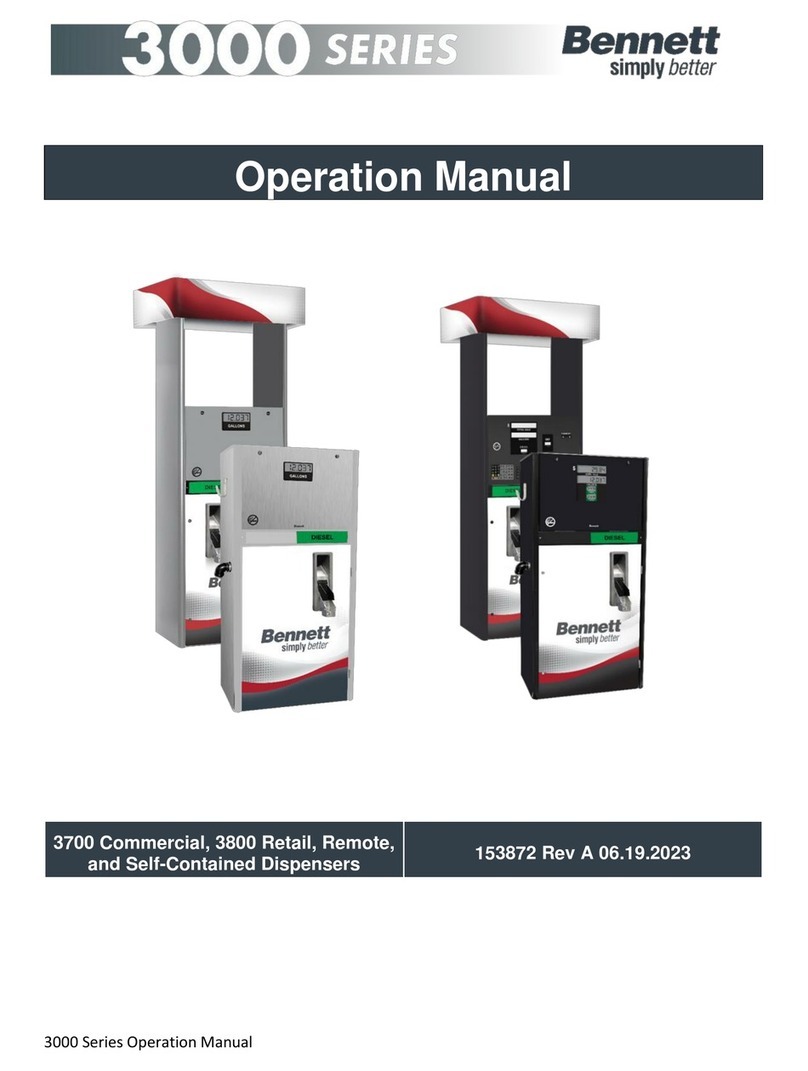
Bennett
Bennett 3000 Series Operation manual
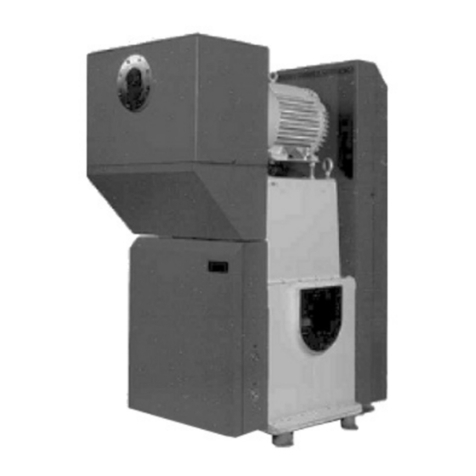
KINNEY
KINNEY KT VFP Series INSTALLATION OPERATION MAINTENANCE REPAIR MANUAL
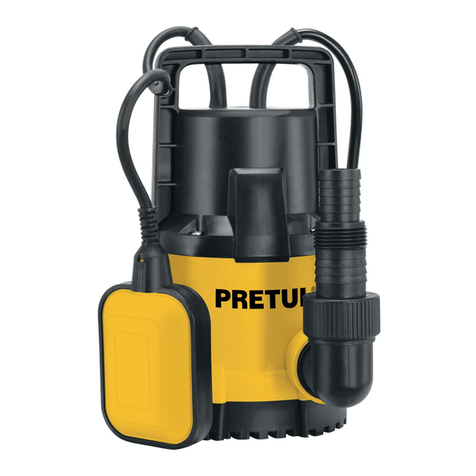
PRETUL
PRETUL BOS-1/2LPP manual
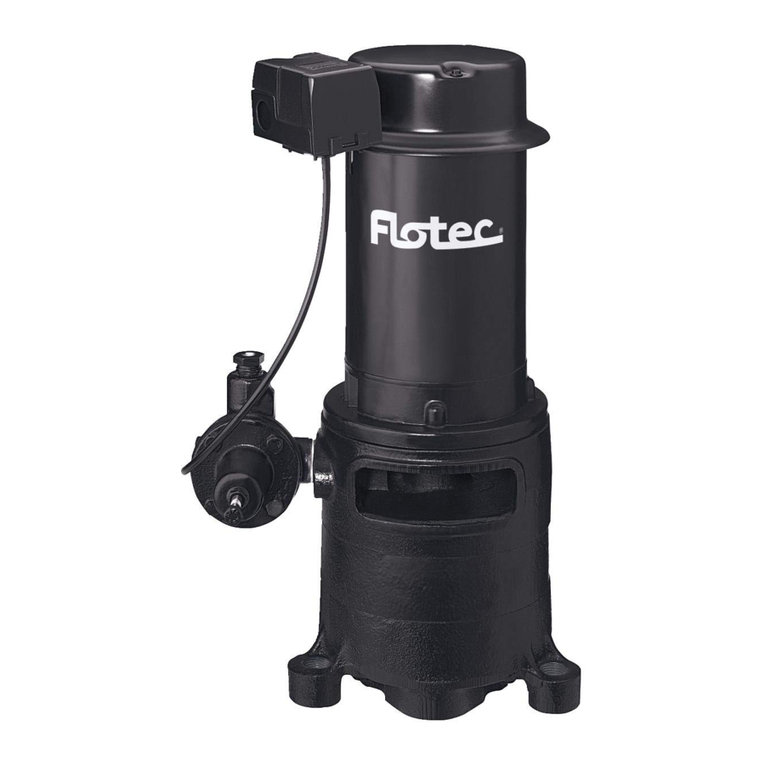
Flotec
Flotec FP0S1800A owner's manual
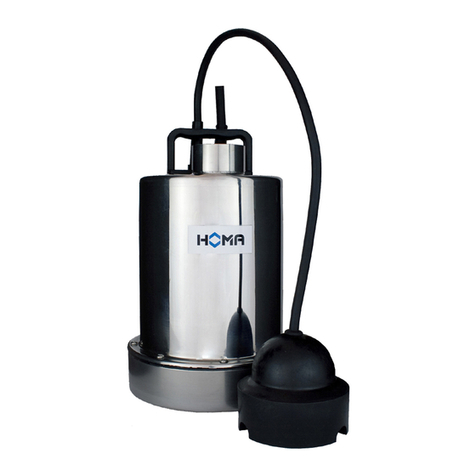
Homa
Homa Sensoflat C 270 WF Original instruction manual
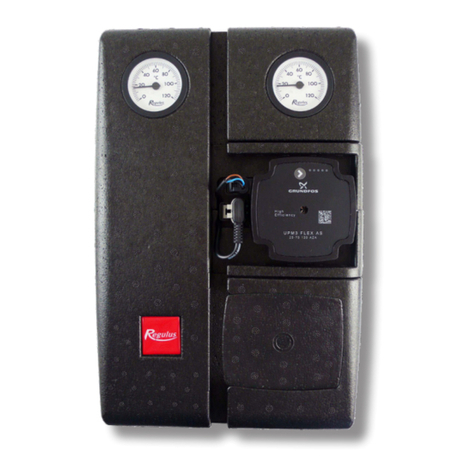
Regulus
Regulus CSE2 MIX-BP F W 1F Installation and operation manual


